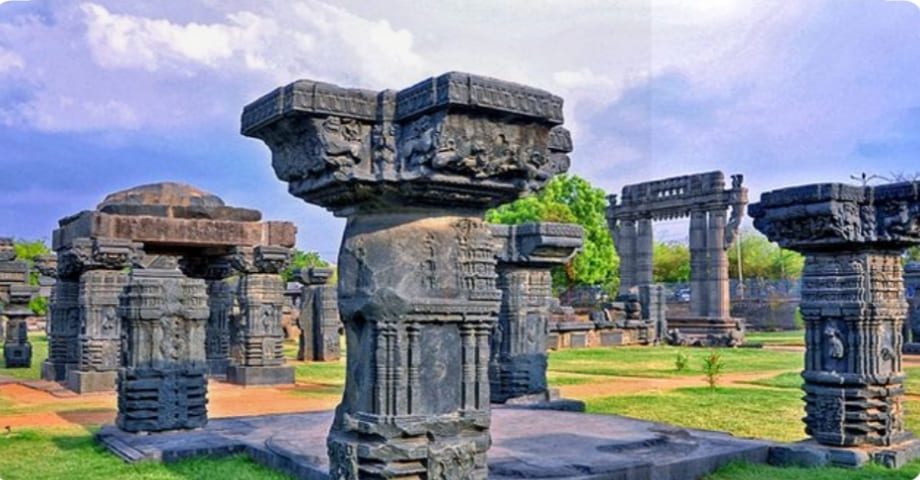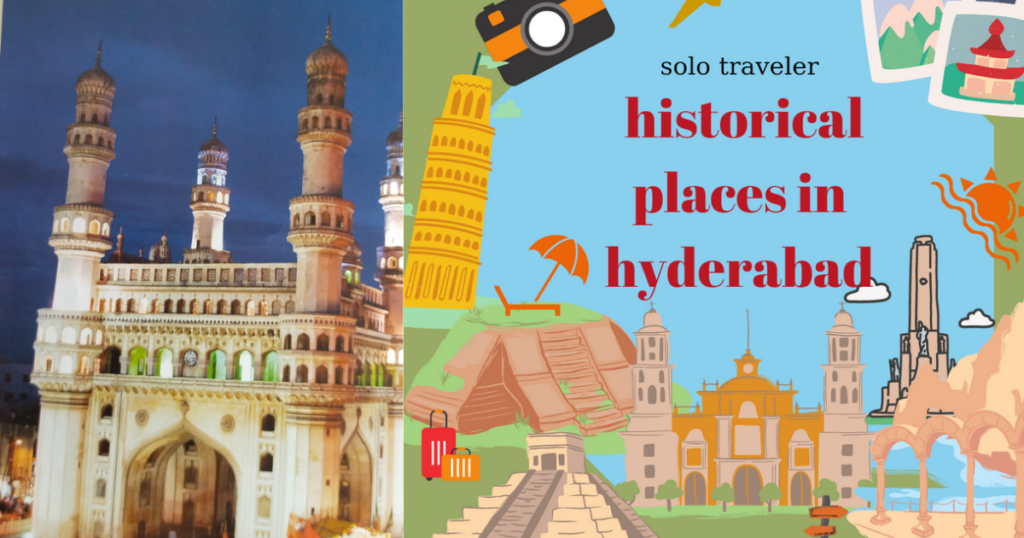Moula Ali Dargah, also known as Hazrat Ali’s Dargah, is more than just a physical structure; it is a living chronicle of Hyderabad cultural identity. The echoes of its past reverberate through the narrow alleys of history, drawing pilgrims and history enthusiasts alike to unravel the mystique that envelopes this sacred site.
As we embark on a journey to explore the significance of Moula Ali Dargah in Hyderabad, we delve into the roots that anchor this spiritual haven in the city’s vibrant heritage. Join us on this expedition, where the echoes of devotion and the whispers of history converge at the sanctified grounds of Moula Ali Dargah.
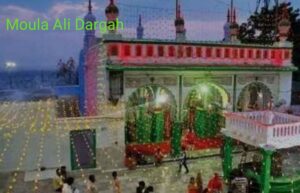
1.Moula Ali Dargah:Historical Tapestry
• Unraveling the historical roots of Moula Ali Dargah
The history of Moula Ali Dargah is a captivating tale that unfolds through the corridors of time, intertwining religious narratives and historical events. To truly understand the significance of this sacred site in Hyderabad, one must journey back to its inception.
1. Early Origins:
The roots of Moula Ali Dargah can be traced to the early days of Hyderabad establishment. Built over 400 years ago during the Qutub Shahi dynasty, the Dargah has weathered the sands of time, witnessing the rise and fall of empires.
2. Spiritual Legacy:
Named after Hazrat Ali, the son-in-law of Prophet Muhammad, Moula Ali Dargah holds immense spiritual significance for the Shia Muslim community. The shrine serves as a testament to the enduring legacy of Hazrat Ali and his teachings, fostering a sense of reverence among devotees who seek solace and blessings at this sacred site.
3. Architectural Marvel of the Qutub Shahi Era:
The Dargah’s architectural splendor reflects the grandeur of the Qutub Shahi era. Intricate carvings, domes, and arches showcase the artistic prowess of the craftsmen of that period. The architectural style seamlessly blends Persian, Turkish, and Indian influences, creating a visual spectacle that stands as a living relic of a bygone era.
4. Historical Significance:
Moula Ali Dargah has been a silent witness to pivotal moments in history. It is said that the Mughal emperor Aurangzeb, during his Deccan campaigns, spared the shrine from destruction due to his respect for Hazrat Ali. This historical incident underscores the enduring respect that transcends religious boundaries.
5. Cultural Mosaic:
Over the centuries, Moula Ali Dargah has evolved into more than just a religious site. It has become a symbol of cultural diversity and communal harmony. The shrine attracts people from various backgrounds, fostering an environment where individuals of different faiths come together to appreciate the shared history and heritage.
6. Custodians of Tradition:
The custodians of Moula Ali Dargah, generation after generation, have played a crucial role in preserving its historical integrity. Their commitment to maintaining the sanctity of the shrine has ensured that the echoes of the past resonate strongly in the present.
Unraveling the historical roots of Moula Ali Dargah unveils a narrative that goes beyond the confines of a religious site. It is a journey through time, where each stone and arch bears witness to the rich tapestry of Hyderabad’s past. As we navigate through the corridors of history, Moula Ali Dargah stands as a beacon, inviting all to partake in the spiritual and historical legacy it graciously holds.
• Connecting the shrine to the broader historical context of Hyderabad
To comprehend the true essence of Moula Ali Dargah, one must situate this sacred shrine within the broader historical tapestry of Hyderabad. The city, known for its rich cultural heritage and dynamic history, serves as the backdrop against which the significance of Moula Ali Dargah becomes even more profound.
1. The Qutub Shahi Dynasty:
Moula Ali Dargah emerged during the reign of the Qutub Shahi dynasty, a period characterized by the flourishing of arts, culture, and architecture. As the rulers of Golconda, the Qutub Shahi kings played a pivotal role in shaping Hyderabad’s identity. The construction of the Dargah exemplifies the architectural prowess of this era, with influences from Persian, Turkish, and Indo-Islamic styles.
2. City of Pearls’ Ascent:
Hyderabad, often referred to as the ‘City of Pearls,’ witnessed a meteoric rise as a center of trade, culture, and governance under the Qutub Shahi rulers. Moula Ali Dargah, nestled atop the Moula Ali Hill, became a spiritual beacon that added a layer of sanctity to the city’s burgeoning prominence.
3. Mughal Influence:
The Mughal influence on Hyderabad’s history is undeniable, and Moula Ali Dargah is no exception. During the Deccan campaigns led by Aurangzeb, the emperor spared the Dargah from destruction, showcasing the respect accorded to this sacred site, which transcended political and religious affiliations.
4. Nizam’s Era:
The Nizams, who succeeded the Qutub Shahi dynasty, continued to shape Hyderabad’s destiny. Moula Ali Dargah, nestled within the city’s boundaries, became a symbol of continuity, a link to the past that persisted through changing dynasties and rulers.
5. Cultural Mosaic of Hyderabad:
As Hyderabad blossomed into a cultural mosaic, Moula Ali Dargah played a crucial role in fostering religious tolerance and communal harmony. Its sacred grounds became a meeting point for people from diverse backgrounds, emphasizing the inclusive spirit that has defined the city’s cultural fabric.
6. Modern Hyderabad:
Even in the contemporary era, Moula Ali Dargah retains its historical significance. Amidst the bustling urban landscape, the shrine stands as a testament to Hyderabad’s ability to seamlessly blend the old with the new. Pilgrims and visitors alike continue to be drawn to the Dargah, connecting with the city’s past while embracing its vibrant present.
Understanding Moula Ali Dargah necessitates acknowledging its symbiotic relationship with the broader historical context of Hyderabad. As we explore this sacred shrine, we embark on a journey through the annals of time, witnessing the interplay of cultures, dynasties, and influences that have shaped both the Dargah and the city it calls home.
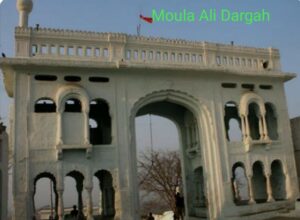
2. Moula Ali Dargah: Architectural Grandeur
• Immersing readers in the distinctive architecture of Moula Ali Dargah
The architectural splendor of Moula Ali Dargah is a mesmerizing blend of artistic finesse and historical significance. As we embark on a visual journey through this sacred space, the distinctive features of its architecture come to life, offering a glimpse into the craftsmanship that has withstood the test of time.
1. Domes and Minarets:
The skyline of Moula Ali Dargah is adorned with majestic domes and minarets, each intricately designed to capture the essence of Islamic architecture. These towering structures not only serve as visual landmarks but also symbolize spiritual elevation, inviting visitors to gaze upwards in awe.
2. Decorative Elements:
Every inch of Moula Ali Dargah is adorned with intricate carvings, arabesques, and calligraphy. The walls and pillars bear the mark of skilled artisans who have translated devotion into stone. Floral patterns, geometric designs, and verses from the Quran seamlessly merge to create a harmonious visual tapestry.
3. Archways and Portals:
The archways of Moula Ali Dargah beckon visitors into a sacred realm. Each arch is a testament to the influence of Persian and Turkish architectural styles, characterized by pointed arches and ornate detailing. These portals serve as transitional spaces, inviting pilgrims to cross from the secular to the sacred.
4. Courtyard and Open Spaces:
The expansive courtyard of Moula Ali Dargah provides a sense of openness and tranquility. Surrounded by arcades and prayer halls, the courtyard is a communal space where devotees gather for prayers and reflection. The open design fosters a sense of inclusivity, inviting all to participate in the spiritual ambiance.
5. Symbolic Elements:
Within the architecture lie numerous symbolic elements that add layers of meaning to Moula Ali Dargah. The ‘Charminar’ or four minarets represent the four caliphs in Islam, while the central dome symbolizes the spiritual ascension of Hazrat Ali. Each element is a visual language that communicates the spiritual narrative embedded in the shrine.
6. Preservation of Heritage:
The meticulous preservation of Moula Ali Dargah’s architectural heritage is evident in the restoration efforts undertaken over the years. The custodians of the shrine have ensured that the original charm and authenticity of the structure remain intact, allowing future generations to marvel at the same architectural brilliance.
7. Play of Light and Shadow:
As sunlight filters through the arches and domes, a captivating play of light and shadow unfolds within Moula Ali Dargah. This interplay accentuates the architectural details, creating a dynamic visual experience that evolves with the changing angles of the sun.
Immersing oneself in the distinctive architecture of Moula Ali Dargah is akin to traversing through a living museum of Islamic art and craftsmanship. The symphony of design elements, the grandeur of the domes, and the spiritual symbolism embedded in every nook and cranny collectively contribute to the architectural poetry that defines this sacred space.
• Describing the unique features that make the shrine an architectural marvel
Moula Ali Dargah, perched atop Moula Ali Hill in Hyderabad, is not just a religious edifice; it is an architectural marvel that captivates the senses with its distinctive features. As we delve into the intricacies of its design, a tapestry of unique elements unfolds, showcasing the brilliance that sets this shrine apart.
1. Architectural Fusion:
One of the most striking features of Moula Ali Dargah is its seamless blend of architectural styles. Rooted in Islamic design principles, the shrine incorporates influences from Persian, Turkish, and Indo-Islamic architectures. This fusion creates a visual symphony that resonates with the cultural diversity of Hyderabad.
2. Towering Minarets:
The four towering minarets, known as the ‘Charminar,’ stand as sentinels of spirituality. Rising majestically, these minarets not only serve as symbols of the four caliphs in Islam but also contribute to the shrine’s commanding presence on the city’s skyline. The intricate detailing on each minaret reflects a commitment to craftsmanship.
3. Ornate Calligraphy:
As one explores Moula Ali Dargah, the prominence of calligraphy becomes evident. Arabic inscriptions from the Quran and verses eulogizing Hazrat Ali adorn the walls. The calligraphic artistry serves not only a decorative purpose but also acts as a visual representation of the shrine’s spiritual significance.
4. Grandiose Domes:
The central dome, rising above Moula Ali Dargah, is a crowning jewel of its architecture. Ornately designed and embellished, the dome symbolizes the spiritual ascension of Hazrat Ali. Its grandiosity is not merely a testament to the skills of the architects but also an invitation to contemplate the divine within.
5. Courtyard Symmetry:
The expansive courtyard, surrounded by arcades and prayer halls, is a testament to the symmetrical brilliance of the shrine. The meticulous layout reflects a sense of order and balance, creating a harmonious space for communal gatherings, prayers, and moments of introspection.
6. Symbolic Water Features:
Water features, such as fountains and pools, punctuate the architecture of Moula Ali Dargah. Beyond their aesthetic appeal, these features hold symbolic significance in Islamic tradition, representing purity and the life-giving essence of water. They contribute to the immersive experience of the shrine.
7. Preservation of Heritage Materials:
The use of heritage materials in the construction of Moula Ali Dargah adds another layer of uniqueness. From locally sourced stones to traditional building techniques, every aspect of the shrine’s construction reflects a commitment to preserving the cultural heritage of Hyderabad.
8. Inclusive Spaces:
Moula Ali Dargah’s architecture fosters inclusivity. The open courtyard, accessible prayer halls, and welcoming arcades create spaces that transcend religious boundaries. This inclusivity is not just a philosophical concept but a design principle that invites people of all backgrounds to partake in the spiritual ambiance.
Moula Ali Dargah’s architectural marvel lies not only in its individual elements but in the cohesive symphony they create. The fusion of diverse influences, the meticulous detailing, and the spiritual symbolism woven into every facet make this shrine a living testament to the extraordinary craftsmanship that defines Hyderabad’s cultural legacy.
• Analyzing the blend of artistic influences in the construction
Moula Ali Dargah stands as a testament to the rich tapestry of artistic influences that have converged in its construction. The synthesis of diverse styles and cultural motifs within the shrine’s architecture creates a visual narrative that is both compelling and historically significant.
1. Persian Architectural Flourish:
The infusion of Persian architectural elements is unmistakable in Moula Ali Dargah. Delicate tile work, intricate geometric patterns, and the use of vibrant colors echo the aesthetics of Persian craftsmanship. These elements, seamlessly integrated into the structure, pay homage to the artistic traditions that flourished in the Persian cultural sphere.
2. Turkish Inspirations:
The architectural contours of Moula Ali Dargah draw inspiration from Turkish design principles. The pointed arches, characteristic of Turkish architecture, are prominently featured in the archways and entrances. This influence adds a layer of sophistication and elegance, contributing to the shrine’s overall visual appeal.
3. Indo-Islamic Synthesis:
At the heart of Moula Ali Dargah’s architecture lies a harmonious fusion of Indo-Islamic design. The incorporation of indigenous materials, coupled with traditional building techniques, reflects a sensitivity to the local context. This synthesis of regional and Islamic architectural elements creates a unique identity for the shrine within the broader cultural landscape of Hyderabad.
4. Calligraphic Elegance:
The art of calligraphy, a quintessential feature of Islamic artistic expression, is masterfully woven into the fabric of Moula Ali Dargah. Arabic inscriptions from the Quran and poetic verses celebrating Hazrat Ali adorn the walls. The calligraphic elegance not only serves a decorative purpose but also elevates the spiritual ambiance of the shrine.
5. Cultural Crossroads:
As a cultural crossroads, Moula Ali Dargah reflects the confluence of artistic influences from various regions. The shrine becomes a living canvas where different traditions converge, showcasing the interconnectedness of diverse cultures and their impact on the architectural landscape.
6. Symbolism in Design:
Every arch, dome, and minaret in Moula Ali Dargah carries symbolic significance. The ‘Charminar,’ representing the four caliphs, and the central dome symbolizing the spiritual ascent of Hazrat Ali are intricately designed elements that convey a deeper narrative. The thoughtful incorporation of symbolism adds layers of meaning to the overall architectural composition.
7. Preservation of Artistic Heritage:
The preservation of artistic heritage is a cornerstone of Moula Ali Dargah’s construction. The commitment to using heritage materials and maintaining traditional building techniques underscores a dedication to preserving the authenticity of the artistic influences that have shaped the shrine.
In analyzing the blend of artistic influences in the construction of Moula Ali Dargah, one witnesses a masterful synthesis that transcends cultural and geographical boundaries. It is a living testament to the interconnectedness of artistic traditions, creating an architectural masterpiece that not only stands as a religious symbol but also as a beacon of cultural harmony.
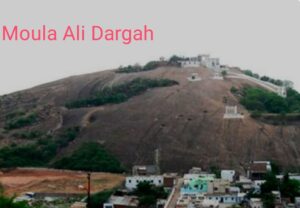
3. Moula Ali Dargah: Cultural Crossroads
• Moula Ali Dargah as a melting pot of diverse cultures
Moula Ali Dargah transcends its religious significance to emerge as a true melting pot, where the rich tapestry of diverse cultures interweaves seamlessly. This sacred shrine atop Moula Ali Hill in Hyderabad serves as a meeting ground for people from various backgrounds, fostering a spirit of inclusivity and cultural harmony.
1. Communal Gatherings and Festivities:
Moula Ali Dargah plays host to communal gatherings and festivities that attract individuals from diverse cultural backgrounds. Whether it’s during religious celebrations or special events, the shrine becomes a shared space where people come together to celebrate, exchange cultural practices, and strengthen the bonds that transcend religious boundaries.
2. Interfaith Interactions:
The open and welcoming ambiance of Moula Ali Dargah encourages interfaith interactions. Visitors from different religious backgrounds coexist in harmony, engaging in dialogue and shared experiences. The shrine becomes a symbol of unity, where cultural diversity is not just accepted but celebrated.
3. Cultural Artifacts and Offerings:
Devotees and visitors bring with them cultural artifacts and offerings that reflect the diversity of their backgrounds. The vibrant array of offerings, from traditional garments to cultural symbols, transforms Moula Ali Dargah into a repository of cultural expressions. Each item left as an offering becomes a testament to the myriad cultures converging at this sacred site.
4. Inclusive Architecture:
The architecture of Moula Ali Dargah itself promotes inclusivity. The open courtyard, accessible prayer halls, and welcoming spaces are designed to accommodate people from all walks of life. This inclusivity in design fosters an environment where cultural differences are not barriers but bridges connecting individuals.
5. Shared Devotion and Respect:
Despite being rooted in Shia Islamic traditions, Moula Ali Dargah is revered and respected by people of various faiths. The shared devotion to the spiritual sanctity of the shrine creates a bond that goes beyond religious affiliations. Pilgrims, irrespective of their cultural backgrounds, find solace and spiritual connection within the hallowed grounds of the Dargah.
6. Cultural Events and Performances:
Moula Ali Dargah becomes a venue for cultural events and performances that showcase the artistic diversity of the community. Traditional music, dance, and cultural performances become a regular feature, offering a platform for artists to share their heritage with a broader audience.
7. Culinary Diversity:
The surroundings of Moula Ali Dargah become a microcosm of culinary diversity. Local vendors and eateries offer a spectrum of dishes representing various cultures. Pilgrims and visitors partake in the flavors of different cuisines, creating a culinary mosaic that mirrors the cultural amalgamation at the shrine.
8. Cultural Exchange Initiatives:
Various cultural exchange initiatives organized around Moula Ali Dargah further highlight its role as a melting pot. Collaborations, workshops, and events facilitate a deeper understanding of different cultures, fostering an environment where diversity is not just acknowledged but embraced.
In essence, Moula Ali Dargah goes beyond being a religious site; it emerges as a living testament to the harmonious coexistence of diverse cultures. Here, cultural differences are not only accepted but celebrated, making the shrine a beacon of unity in the heart of Hyderabad.
• Discussing the influence of different cultural elements on the shrine
Moula Ali Dargah stands as a living canvas upon which the brushstrokes of various cultural influences have painted a vibrant tapestry. This sacred shrine in Hyderabad bears the imprints of diverse cultures, creating a nuanced and enriching experience that extends far beyond its religious significance.
1. Architectural Synthesis:
The architectural design of Moula Ali Dargah is a testament to the fusion of cultural elements. Persian, Turkish, and Indo-Islamic architectural styles intermingle harmoniously, creating a visual masterpiece that reflects the cultural amalgamation within the shrine. The arches, domes, and minarets speak a universal language that transcends cultural boundaries.
2. Symbolism and Iconography:
The symbolic elements within the shrine draw upon various cultural motifs. The ‘Charminar,’ representing the four caliphs, is a nod to Islamic symbolism, while the central dome’s spiritual significance resonates across cultures. The inclusive iconography ensures that people from diverse cultural backgrounds find resonance in the shrine’s symbolic language.
3. Rituals and Practices:
The rituals and practices observed at Moula Ali Dargah are imbued with cultural nuances. While rooted in Shia Islamic traditions, the shrine accommodates variations in how individuals approach their devotions. Pilgrims from different cultures bring unique customs and practices, creating a mosaic of diverse spiritual expressions.
4. Calligraphic Elegance:
The calligraphy adorning the walls of the Dargah is a reflection of cultural diversity. Arabic inscriptions from the Quran share space with verses eulogizing Hazrat Ali, showcasing the melding of linguistic and cultural influences. The art of calligraphy becomes a universal bridge connecting devotees from various cultural backgrounds.
5. Cultural Artifacts and Offerings:
Devotees contribute cultural artifacts and offerings, each bearing the stamp of their cultural identity. Traditional garments, symbols, and artifacts left at the shrine create a visual tableau of the diverse cultures converging at Moula Ali Dargah. The offerings become tangible expressions of cultural heritage and reverence.
6. Festivals and Celebrations:
Moula Ali Dargah becomes a cultural crossroads during festivals and celebrations. Whether it’s the observance of Islamic festivals or events that transcend religious boundaries, the shrine becomes a venue for cultural festivities. The rhythmic beats of traditional music and the vibrant colors of cultural performances fill the air, creating an atmosphere of joy and celebration.
7. Interfaith Harmony:
The influence of different cultural elements is perhaps most palpable in the spirit of interfaith harmony fostered at Moula Ali Dargah. Visitors from diverse cultural and religious backgrounds coexist in mutual respect, forging connections that transcend the confines of individual beliefs. The shrine becomes a microcosm of cultural understanding and unity.
In essence, Moula Ali Dargah is a testament to the universal language of spirituality that transcends cultural boundaries. The shrine’s embrace of diverse cultural elements not only enriches its atmosphere but also serves as a beacon of unity, where people from different walks of life converge to celebrate their shared humanity.
• Examining the role of the Dargah in promoting cultural harmony in Hyderabad
Moula Ali Dargah, perched on the Moula Ali Hill, extends its influence beyond religious realms, playing a pivotal role in fostering cultural harmony within the diverse tapestry of Hyderabad. The shrine serves as a catalyst for unity, transcending cultural boundaries and acting as a unifying force in this cosmopolitan city.
1. Inclusive Spiritual Space:
Moula Ali Dargah is an inclusive spiritual haven that welcomes people from all cultural backgrounds. Regardless of religious affiliations, individuals find common ground within its sacred precincts. The open architecture and welcoming atmosphere facilitate a sense of belonging for everyone who seeks solace or spiritual connection.
2. Interfaith Dialogues and Understanding:
The Dargah serves as a natural platform for interfaith dialogues and understanding. Pilgrims and visitors, irrespective of their religious beliefs, engage in meaningful conversations and share perspectives. This exchange of ideas fosters a deeper understanding of diverse cultural and religious traditions, promoting a sense of unity among Hyderabad’s residents.
3. Cultural Festivals and Events:
Moula Ali Dargah becomes a vibrant hub during cultural festivals and events. The celebration of Islamic festivals, combined with cultural performances that transcend religious boundaries, transforms the shrine into a cultural melting pot. This amalgamation of festivities encourages people to appreciate and celebrate each other’s cultural practices.
4. Communal Gatherings:
The shrine acts as a natural meeting point for communal gatherings. Whether it’s during religious ceremonies, special occasions, or regular days of worship, people from diverse cultural backgrounds converge at Moula Ali Dargah. This shared space becomes a microcosm of Hyderabad’s cultural diversity, fostering a sense of community and togetherness.
5. Cultural Exhibitions and Expositions:
Moula Ali Dargah provides a venue for cultural exhibitions and expositions that showcase the artistic heritage of different communities. From traditional art forms to culinary delights, these events create opportunities for cultural exchange, allowing residents and visitors alike to immerse themselves in the rich diversity of Hyderabad’s cultural landscape.
6. Symbol of Unity:
As a revered symbol in Hyderabad, Moula Ali Dargah stands as a testament to unity. Its significance is not confined to a single community but resonates with people from various cultural backgrounds. The shrine’s role as a symbol of unity goes beyond religious harmony; it embodies the idea that cultural diversity is a source of strength and richness for the entire community.
7. Educational Initiatives:
Moula Ali Dargah actively engages in educational initiatives that promote cultural understanding. Workshops, seminars, and educational programs encourage dialogue about the shared history and cultural heritage of Hyderabad. These initiatives contribute to breaking down stereotypes and fostering a sense of mutual respect.
Moula Ali Dargah is not just a religious site; it is a cultural bridge that connects the diverse communities of Hyderabad. Through its inclusive approach, interfaith dialogues, cultural events, and educational initiatives, the shrine plays a pivotal role in promoting cultural harmony, fostering a sense of unity that resonates throughout the heart of the city.
4.Moula Ali Dargah: Geographic Marvel
•Pinpointing the location of Moula Ali Dargah in Hyderabad
Moula Ali Dargah is strategically located atop Moula Ali Hill in Hyderabad, Telangana, India. Situated to the northeast of the city, the shrine offers panoramic views of Hyderabad and its surroundings. Visitors can access Moula Ali Dargah by navigating towards the Moula Ali area, and from there, ascend the hill to reach the sacred grounds. The precise geographical coordinates of the Dargah are approximately 17.4517° N latitude and 78.5226° E longitude. This location places Moula Ali Dargah as a prominent landmark within the cultural and religious landscape of Hyderabad.
• Offering insights into the scenic surroundings and views from the shrine
Moula Ali Dargah, perched atop Moula Ali Hill in Hyderabad, offers a captivating vantage point that extends beyond its spiritual significance. The scenic surroundings and panoramic views from the shrine create an immersive experience for visitors, adding an extra layer of allure to this sacred site.
1. Cityscape Panorama:
From Moula Ali Hill, visitors are treated to a breathtaking panorama of Hyderabad’s cityscape. The sprawling urban landscape, punctuated by modern structures and historical landmarks, unfolds beneath the Dargah. The juxtaposition of the serene shrine against the dynamic cityscape creates a striking visual contrast.
2. Sunrise and Sunset Spectacle:
One of the most enchanting experiences at Moula Ali Dargah is witnessing the sunrise or sunset from its elevated location. The changing hues of the sky cast a warm glow over the city, painting a mesmerizing tableau that transforms the spiritual ambiance into a serene and picturesque scene.
3. Deccan Plateau Views:
Moula Ali Hill’s elevation provides panoramic views of the Deccan Plateau. The undulating terrain, adorned with greenery, stretches into the horizon. This natural backdrop enhances the tranquility of the shrine and offers a peaceful escape from the bustling city life below.
4. Charminar and Old City Silhouette:
In the distance, the iconic Charminar and the historic structures of the Old City create a silhouette against the Hyderabad skyline. The blend of ancient architectural marvels and the modern cityscape forms a captivating ensemble visible from the Dargah, encapsulating the city’s rich historical tapestry.
5. Navigating the Landscape:
The Dargah’s location allows visitors to appreciate the intricate network of roads, neighborhoods, and landmarks. Observing the city’s layout from this vantage point provides a unique perspective, offering insights into the interconnectedness of Hyderabad’s diverse communities.
6. Greenery and Natural Beauty:
Surrounded by lush greenery, Moula Ali Hill itself adds a touch of natural beauty to the surroundings. The well-maintained gardens and the hill’s flora contribute to the overall aesthetics, creating a serene environment that complements the spiritual ambiance of the shrine.
7. Cultural and Religious Diversity Below:
As the eyes sweep across the landscape, one can observe the diverse neighborhoods and communities that make up Hyderabad’s social fabric. The coexistence of various cultural and religious spaces below reinforces the city’s identity as a melting pot of traditions.
In essence, Moula Ali Dargah elevated location not only offers a sanctuary for spiritual reflection but also provides a visual feast for those seeking to appreciate the dynamic and diverse landscape of Hyderabad. The scenic surroundings and panoramic views contribute to making the visit a holistic and enriching experience.
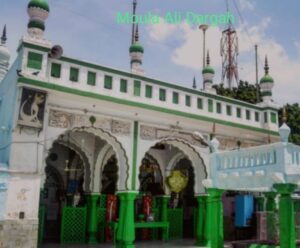
• Guidance on how to reach the Dargah for interested visitors
For interested visitors seeking to experience the spiritual ambiance and scenic views of Moula Ali Dargah, here is a guide on how to reach this sacred shrine in Hyderabad:
• By Road:
Personal Vehicle: Visitors can reach Moula Ali Dargah by using GPS navigation and heading towards the Moula Ali area in Hyderabad. The shrine is well-connected by roads, and ample parking facilities are available at the base of Moula Ali Hill.
• Public Transportation:
Bus: Hyderabad has an extensive public bus network. Visitors can inquire about buses heading towards Moula Ali and disembark at a convenient stop.
• Auto-rickshaw or Taxi: Auto-rickshaws and taxis are readily available in Hyderabad. Visitors can hire one and provide the destination as Moula Ali Dargah.
• On Foot:
The adventurous can choose to trek up Moula Ali Hill to reach the Dargah. The climb offers a scenic journey, and the serenity of the surroundings adds to the spiritual experience.
• By Train:
The closest railway station to Moula Ali Dargah is the Secunderabad Junction. From there, visitors can hire a taxi or use public transportation to reach the Moula Ali area. The Dargah is approximately a 30-minute drive from the railway station.
• By Air:
For those arriving by air, the Rajiv Gandhi International Airport in Hyderabad is the nearest airport. Visitors can hire a taxi or use app-based ride services to reach Moula Ali Dargah from the airport. The journey takes around 45 minutes, depending on traffic conditions.
• Guidance for the Ascent:
Once at the base of Moula Ali Hill, visitors can ascend to the Dargah by foot or use the available stairs. The climb is manageable, and the effort is rewarded with panoramic views and a tranquil atmosphere.
• Important Tips:
Comfortable Attire: Wear comfortable and modest clothing, respecting the religious and cultural atmosphere of the Dargah.
• Footwear: It is customary to remove footwear before entering the shrine. Visitors can carry them or use the designated footwear storage areas.
• Respectful Conduct: Maintain a respectful demeanor within the shrine premises, adhering to the religious and cultural practices observed.
By following these guidelines, interested visitors can embark on a meaningful journey to Moula Ali Dargah, immersing themselves in its spiritual aura and enjoying the scenic beauty that surrounds this sacred site.
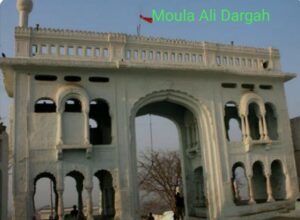
6.Moula Ali Dargah: Local Flavor
• Highlighting local attractions and activities around Moula Ali Dargah
While Moula Ali Dargah itself is a prominent attraction in Hyderabad, the surrounding area offers a variety of local attractions and activities for visitors to explore. Here are some highlights:
1.Moula Ali Hill Park:
Enjoy a serene stroll in the Moula Ali Hill Park located in the vicinity of the Dargah. The park offers green spaces and a peaceful environment for relaxation.
2.Shamirpet Lake:
Nature enthusiasts can visit Shamirpet Lake, a picturesque water body surrounded by lush greenery. It’s a perfect spot for a leisurely picnic or a boat ride.
3.Katta Maisamma Temple:
Located nearby, Katta Maisamma Temple is a popular Hindu temple. Visitors can explore the temple’s architecture and witness the religious rituals.
4.Medchal Fort:
History buffs can venture to Medchal Fort, an ancient fortification with historical significance. The fort offers panoramic views of the surrounding landscape.
5.Gandipet (Osman Sagar) Lake:
Osman Sagar, also known as Gandipet, is a serene lake surrounded by hills. It’s a great place for a day outing, offering boating facilities and a peaceful atmosphere.
6.Ananda Buddha Vihara Temple:
For those interested in Buddhism, the Ananda Buddha Vihara Temple is a serene Buddhist temple with beautiful architecture and tranquil surroundings.
7.Cultural Exploration in Old City:
Take a trip to the Old City of Hyderabad to explore historical landmarks like Charminar, Mecca Masjid, and Laad Bazaar. Indulge in the vibrant street life and savor local delicacies.
8.Qutub Shahi Tombs:
Visit the Qutub Shahi Tombs, a complex of tombs and mosques dedicated to the rulers of the Qutub Shahi dynasty. The architectural splendor and historical significance make it a compelling site.
9.Eatery Exploration:
Hyderabad is renowned for its culinary delights. Visitors can explore local eateries to savor Hyderabadi biryani, kebabs, and other traditional dishes.
10. Shopping at Moula Ali Market:
Moula Ali Market offers a chance to experience local shopping. Visitors can explore the market for traditional clothing, jewelry, and handicrafts.
11. Adventure at Runway 9:
For thrill-seekers, Runway 9 is an adventure sports complex with go-karting and other adrenaline-pumping activities.
12.Necklace Road:
Enjoy a leisurely evening stroll or boat ride along Necklace Road, which runs alongside the Hussain Sagar Lake. The scenic views and cool breeze make it a popular spot for locals and visitors alike.
Whether exploring historical sites, enjoying nature, or indulging in local cuisine, the area around Moula Ali Dargah provides a diverse range of attractions and activities for a well-rounded and enjoyable visit.
Conclusion:
Embarking on a journey through Moula Ali Dargah unveils a tapestry woven with historical threads and cultural richness. Rooted in the era of the Qutub Shahi dynasty, this sacred shrine transcends time, seamlessly blending Persian, Turkish, and Indo-Islamic influences in its architectural splendor. Navigating the city’s historical epochs, from Mughal rule to the Nizam era, Moula Ali Dargah emerges as more than a religious site. It stands as a symbol of inclusivity, uniting diverse cultures in the heart of Hyderabad. Today, its elevated perch not only offers panoramic views but also elevates the spirit, embodying Hyderabad’s cultural harmony.
FAQs:
1.What is the story of Moula Ali Dargah?
2.What is Moulali famous for?
3.What is the best time to visit Moula Ali hill?
4.How many steps are there in Moula Ali Dargah?
5.Moula Ali Dargah distance
6.Moula Ali Dargah history
7.Moula Ali Dargah location
8.Moula Ali Dargah timings
9.Moula Ali Dargah in Hyderabad
10.Moula ali direction
